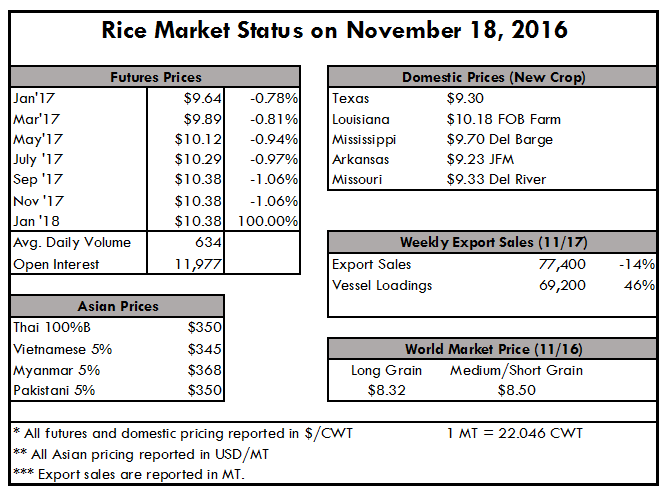
[vc_row][vc_column][vc_column_text css=".vc_custom_1479511321414{background-position: center !important;background-repeat: no-repeat !important;background-size: cover !important;}"]
[/vc_column_text][/vc_column][/vc_row][vc_row css=".vc_custom_1477705217949{border-radius: 3px !important;}"][vc_column][special_heading title="Rice Market Update" subtitle="" separator="no" font_size="30px" font_weight="700" text_transform="none" heading_margin_bottom="0"][vc_column_text css=".vc_custom_1479509271603{border-top-width: 3px !important;border-right-width: 1px !important;border-bottom-width: 1px !important;border-left-width: 1px !important;padding-top: 10px !important;padding-right: 10px !important;padding-bottom: 10px !important;padding-left: 10px !important;border-left-color: #81d742 !important;border-left-style: solid !important;border-right-color: #81d742 !important;border-right-style: solid !important;border-top-color: #81d742 !important;border-top-style: solid !important;border-bottom-color: #81d742 !important;border-bottom-style: solid !important;}"]

This week at the South Louisiana Rail Facility near Lacassine, Louisiana, rail cars loaded with the variety CL111 are bound Mexico. The ability to ship identity preserved rice has been an important option for area farmers. Each car hold approximately 82 tons of rough rice.
The Thanksgiving holiday is just around the corner and the rice market has already begun to wind down from its already slow pace. There has been very little news to report in the past week as a result. Cash pricing has not moved significantly at all, with any shifts being attributable to changes in the futures market. Growers across the U.S. are finishing up bedding down the 2016 crop and taking stock of all of its ramifications. Texas and Louisiana report second crop harvest all but complete, with the final lots expected to be finished before the holiday season. Milling yields remain poor with field yields being reported in the mid 3,000 pound per acre range. Despite the poorer outlook for new crop pricing, field work for the 2017 crop has been well underway in many areas. Rainfall (or lack thereof) has also been a problem in certain areas as the ground has become too difficult to work properly. Early forecasts anticipate that the winter rains are due to start soon, which should lower the curtains on the 2016 crop year. Government reports this week were slim with no real news of any kind to impact the market. The world market price estimate was held constant for the third week in a row, suggesting that the market has hit a boundary at which it will remain stable for the time being. Export sales were off as compared to last week’s numbers, but sales in the 70,000 MT – 80,000 MT range on a constant basis are welcomed. Vessel loadings were reported to be higher this week against old sales. This is a trend that has been in the market for some time, and indicates that the sales volumes are being shipped at a fairly constant rate. This will be key throughout the marketing year as a method of maintaining some movement and liquidity in the cash markets. The futures market saw another difficult week as the November contract quietly left the board to be replaced by the January’17 contract as the nearby. There was a significant amount of volatility in the market over the past week with notable price swings in both directions. With no real fundamental reasons for these fluctuations, it is likely that the impacts of the external financial markets and their associated uncertainty are being amplified in the commodity world. From a volatility standpoint, the continued changes associated with the next presidential administration will be something to pay attention to as will the actions that the Federal Reserve takes with respect to interest rate. Any notable changes in either area will have very visible effects on the futures board. Otherwise, producers are looking to the next crop year with mixed emotions – the goal at this point being not to win big, but to lose small.
 [/vc_column_text][special_heading title="Texas Rice Update" subtitle="By Dr. Mo Way, Professor of Entomology, Texas AgriLife Research and Extension Center" separator="no" font_size="30px" font_weight="700" text_transform="none" heading_margin_bottom="0"][vc_column_text css=".vc_custom_1479509211699{border-top-width: 3px !important;border-right-width: 1px !important;border-bottom-width: 1px !important;border-left-width: 1px !important;padding-top: 10px !important;padding-right: 10px !important;padding-bottom: 10px !important;padding-left: 10px !important;border-left-color: #81d742 !important;border-left-style: solid !important;border-right-color: #81d742 !important;border-right-style: solid !important;border-top-color: #81d742 !important;border-top-style: solid !important;border-bottom-color: #81d742 !important;border-bottom-style: solid !important;}"]We have some very preliminary Texas yield info from 2016 (according to the Texas Rice Crop Survey). About 15,000 acres report an average dry yield of almost 8,000 lb/acre with an average of 60.6% head rice. These figures are excellent, but the verdict is still out until we get final results of the entire survey.
[/vc_column_text][special_heading title="Texas Rice Update" subtitle="By Dr. Mo Way, Professor of Entomology, Texas AgriLife Research and Extension Center" separator="no" font_size="30px" font_weight="700" text_transform="none" heading_margin_bottom="0"][vc_column_text css=".vc_custom_1479509211699{border-top-width: 3px !important;border-right-width: 1px !important;border-bottom-width: 1px !important;border-left-width: 1px !important;padding-top: 10px !important;padding-right: 10px !important;padding-bottom: 10px !important;padding-left: 10px !important;border-left-color: #81d742 !important;border-left-style: solid !important;border-right-color: #81d742 !important;border-right-style: solid !important;border-top-color: #81d742 !important;border-top-style: solid !important;border-bottom-color: #81d742 !important;border-bottom-style: solid !important;}"]We have some very preliminary Texas yield info from 2016 (according to the Texas Rice Crop Survey). About 15,000 acres report an average dry yield of almost 8,000 lb/acre with an average of 60.6% head rice. These figures are excellent, but the verdict is still out until we get final results of the entire survey.

Brent Batchelor and James Engbrock---County Extension Agentswho served the rice industry in Matagorda County for a combined 42 years!
I inspected some ratoon rice near Garwood with Randy Waligura a couple weeks ago. The rice was prematurely brown and dying in areas of many fields. We thought the problem may be the rice planthopper, but this was not the case---I did not find any planthoppers in any of these fields. Much of this rice has been harvested and Randy says yields are down 5-10 barrels per acre in these affected fields. We really do not know why, but Dr. Shane Zhou will inspect these fields for disease problems like panicle blight and/or narrow brown leaf spot.
Yesterday I drove to Bay City to say goodbye to a great friend and colleague---and I know many of you hold this Extension scientist in the highest regard---I’m talking about Brent Batchelor who has been CEA for Matagorda Co. for the past 17 years! He is moving on to Stephenville where he will be in charge of a cadre of CEAs in that part of Texas. Brent has helped my project numerous times over the years. We have worked together on many critters including the rice water weevil, Mexican rice borer, redbanded stink bug, blackbirds, chinch bug, feral hogs and cutworms. He helped all my graduate students with their research, so Brent has been an integral component of my entomology project formany years. I know Brent has helped all the faculty at the Beaumont Center and the Eagle Lake Rice Research Station---thanks so much, Brent, for all your help and insight. On behalf of my colleagues, I wish you the best in your new position---maybe you can now retire your LaCrosse boots (not many flooded rice fields in Stephenville)!
Also, during the going away party for Brent, I caught up with another awesome CEA---James Engbrock---who Brent replaced some 17 years ago. James served Matagorda Co. for 25 years before retiring. He was one of my mentors when I first came on board back in 1982. James taught me the importance of getting in the field and visiting with stakeholders to find out what the problems are so that research can be prioritized. Thank you, James and Brent, for your many years of outstanding service to Texas agriculture![/vc_column_text][special_heading title="Congress to Pass Short-Term CR – Push Appropriations Decisions to 2017" subtitle="" separator="no" font_size="30px" font_weight="700" text_transform="none" heading_margin_bottom="0"][vc_column_text css=".vc_custom_1479499116420{border-top-width: 3px !important;border-right-width: 1px !important;border-bottom-width: 1px !important;border-left-width: 1px !important;padding-top: 10px !important;padding-right: 10px !important;padding-bottom: 10px !important;padding-left: 10px !important;border-left-color: #81d742 !important;border-left-style: solid !important;border-right-color: #81d742 !important;border-right-style: solid !important;border-top-color: #81d742 !important;border-top-style: solid !important;border-bottom-color: #81d742 !important;border-bottom-style: solid !important;}"]Earlier this week, after meeting with President-elect Donald Trump’s transition team, House leaders announced that they will begin work on passing a continuing resolution (CR), extending government funding through the Spring of 2017. The current CR expires on December 9, 2016. Policy makers were considering passing the FY 2017 appropriations bills before adjourning at the end of this year, but the election of Donald Trump led many Republicans in Congress to support pushing those negotiations to allow the Trump administration to weigh in.[/vc_column_text][special_heading title="House Passes Legislation to Block Midnight Regulations" subtitle="" separator="no" font_size="30px" font_weight="700" text_transform="none" heading_margin_bottom="0"][vc_column_text css=".vc_custom_1479499211018{margin-bottom: 15px !important;border-top-width: 3px !important;border-right-width: 1px !important;border-bottom-width: 1px !important;border-left-width: 1px !important;padding-top: 5px !important;padding-right: 10px !important;padding-bottom: 10px !important;padding-left: 10px !important;border-left-color: #81d742 !important;border-left-style: solid !important;border-right-color: #81d742 !important;border-right-style: solid !important;border-top-color: #81d742 !important;border-top-style: solid !important;border-bottom-color: #81d742 !important;border-bottom-style: solid !important;}"]This week, the U.S. House of Representatives passed legislation to allow Congress to pass a single resolution to block multiple regulations completed during the final stretch of a president’s term. The Block Multiple Midnight Rules Act, sponsored by Rep. Darrell Issa (R-CA) has already received a veto threat from the White House, and largely serves as an agenda-setting item, and a reminder of what is to come in the next administration. Under the Congressional Review Act, Congress has 60 legislative days after a rule is completed to introduce a joint resolution of disapproval – currently, a separate bill is required for each regulatory measure. This legislation would allow Congress to lump the disapprovals into one standalone measure.[/vc_column_text][vc_column_text css=".vc_custom_1479499452999{margin-top: 20px !important;margin-right: 10px !important;margin-bottom: 20px !important;margin-left: 10px !important;border-top-width: 2px !important;border-right-width: 2px !important;border-bottom-width: 2px !important;border-left-width: 2px !important;padding-top: 25px !important;padding-right: 25px !important;padding-bottom: 25px !important;padding-left: 25px !important;background-color: #ffffff !important;border-left-color: #aa3027 !important;border-left-style: double !important;border-right-color: #aa3027 !important;border-right-style: double !important;border-top-color: #aa3027 !important;border-top-style: double !important;border-bottom-color: #aa3027 !important;border-bottom-style: double !important;}"]The latest Texas Rice Crop Survey reports (updated through Friday, November 18, 2016) are available through the Beaumont Center web site at http://beaumont.tamu.edu/CropSurvey/
The crop survey provides detailed data on rice acreage across the Texas rice belt, including information on varieties and crop development.[/vc_column_text][special_heading title="House and Senate Re-elect New Leaders" subtitle="" separator="no" font_size="30px" font_weight="700" text_transform="none" heading_margin_bottom="15"][vc_column_text css=".vc_custom_1479499237746{margin-bottom: 15px !important;border-top-width: 3px !important;border-right-width: 1px !important;border-bottom-width: 1px !important;border-left-width: 1px !important;padding-top: 5px !important;padding-right: 10px !important;padding-bottom: 10px !important;padding-left: 10px !important;border-left-color: #81d742 !important;border-left-style: solid !important;border-right-color: #81d742 !important;border-right-style: solid !important;border-top-color: #81d742 !important;border-top-style: solid !important;border-bottom-color: #81d742 !important;border-bottom-style: solid !important;}"]This week, House and Senate Republicans, and Senate Democrats elected its new leadership team for the 115th Congress. The House and Senate GOP made no major changes, keeping Speaker Paul Ryan (R-WI), Majority Leader Kevin McCarthy (R-CA), Majority Whip Steve Scalise (R-LA), Conference Chair Cathy McMorris Rodgers (R-WA) in the House, and Majority Leader Mitch McConnell (R-KY), Majority Whip John Cornyn (R-TX), and Conference Chair John Thune (R-SD) in the Senate.
With the retirement of Sen. Harry Reid (D-NV), the Senate Democrats elected Sen. Chuck Schumer (D-NV) to take the reins as the new Minority Leader. Sen. Dick Durbin (D-IL) will keep his status as Minority Whip, Sen. Patty Murray (D-WA) was appointed to the newly created position of Assistant Minority Leader, and Sen. Debbie Stabenow (D-MI), who will serve another term as agriculture committee ranking member, will chair the Senate Democrats’ policy and communications team. In another big move, Sen. Patrick Leahy (D-VT), a past former agriculture committee chairman, will serve as the ranking member of the appropriations committee.
The House Democrats chose to delay leadership elections to November 30, in order to assess the election day defeat of Democratic candidate Hillary Clinton, and its impact on the party. Rep. Tim Ryan (D-OH) has announced a challenge to Minority Leader Nancy Pelosi’s (D-CA) position. At this time rumors indicate that she has the votes needed to prevail.[/vc_column_text][special_heading title="USRPA Travels to Morocco to Expand U.S. Rice Market" subtitle="" separator="no" font_size="30px" font_weight="700" text_transform="none" heading_margin_bottom="15"][vc_column_text css=".vc_custom_1479506671737{margin-bottom: 15px !important;border-top-width: 3px !important;border-right-width: 1px !important;border-bottom-width: 1px !important;border-left-width: 1px !important;padding-top: 5px !important;padding-right: 10px !important;padding-bottom: 10px !important;padding-left: 10px !important;border-left-color: #81d742 !important;border-left-style: solid !important;border-right-color: #81d742 !important;border-right-style: solid !important;border-top-color: #81d742 !important;border-top-style: solid !important;border-bottom-color: #81d742 !important;border-bottom-style: solid !important;}"]USRPA’s Market Access and Demand Building program in Morocco focuses on maintaining strong relationships with rice importers and traders in North Africa, through regular visits and support. Importers in Morocco are encouraged to buy more U.S. rice especially with the custom duties on U.S. rice dropping to zero. USRPA coordinates with governmental bodies and use printed materials, such as brochures with information and recipes, as part of its marketing strategy.
Morocco is the most active trading hub in North Africa as it is well-placed geographically, connecting the African continent with Europe. The government has long adopted open-market oriented economy with good diversity (13% agriculture, 29% industry, 58% services). Economy reforms have been endorsed in the past few years that resulted in low inflation and steady economic growth. Morocco enjoys political stability and no security issues compared to neighbouring countries to the west and the south. It is a highly potential conduit for trade to South and West African countries.
Morocco has been actively encouraging foreign investments and had since signed Free Trade Agreements (FTA’s) with many partners, including the USA, the European Union (EU), Turkey, the Mediterranean Arab countries (Tunisia, Egypt and Jordan) and the United Arab Emirates (UAE). The FTA between Morocco and the USA established in 2010 brought down the custom duties on U.S. rice from as high as 172% to zero, effective as of January 2015.
Morocco produces 15% of the local demand for rice. The remaining 85 percent is imported, mainly from the EU, Far East and Egypt. Some of the imported rice is packaged and branded locally, especially that coming from Spain. The market is dominated by Thailand (25% of market share), Spain (25%) and Egypt (15%). The USA holds a market share of 7%. In 2015, Morocco imported 48. 6 MT of U.S. rice, when comparing 2015 to 2016 (Jan-Sept.) imports are 38.5 MT an increase of 175%.
Medium grain rice is the most preferred type of rice for the Moroccan consumer, as it is used in traditional dishes. Long grain regular milled rice and parboiled rice are mostly used in hotels, HRI and foodservice sectors.
Morocco is a price-driven market and competition is intense. The EU has the advantages of geographical proximity, language and pricing. Also, open tax-free exchange routes between Morocco and Spain facilitate trading between the two to a large extent, and allow large volumes of rice to enter Morocco daily.
Morocco’s food distribution network witnessed significant changes with the expansion of a number of retail food outlets and opening of new ones. Two companies dominate the retail scene in Morocco: “Carrefour Markets” owns all Carrefour outlets and Atacadao, while “Marjane Holding” owns all Marjane stores as well as ACIMA and other smaller retail chains. Traditional small scale grocery shops continue to be the first source of shopping particularly in rural areas and small towns. In larger cities, such as Casablanca and Rabat, malls and large scale supermarkets are gaining momentum now. The wholesale markets in Morocco are also very popular destinations for traders and consumers alike.[/vc_column_text][vc_row_inner][vc_column_inner width="1/2"][vc_single_image image="1372" add_caption="yes" alignment="center"][/vc_column_inner][vc_column_inner width="1/2"][vc_single_image image="1371" add_caption="yes"][/vc_column_inner][/vc_row_inner][vc_row_inner][vc_column_inner width="1/2"][vc_single_image image="1370" add_caption="yes"][/vc_column_inner][vc_column_inner width="1/2"][vc_single_image image="1369" add_caption="yes"][/vc_column_inner][/vc_row_inner][/vc_column][/vc_row][vc_row css=".vc_custom_1477697377878{border-top-width: 1px !important;border-right-width: 1px !important;border-bottom-width: 1px !important;border-left-width: 1px !important;border-left-color: #1629a3 !important;border-left-style: solid !important;border-right-color: #1629a3 !important;border-right-style: solid !important;border-top-color: #1629a3 !important;border-top-style: solid !important;border-bottom-color: #1629a3 !important;border-bottom-style: solid !important;border-radius: 3px !important;}"][vc_column][vc_single_image image="1166" alignment="center" css=".vc_custom_1478292913956{margin-top: 25px !important;}"][cta heading="Food and Agriculture Regulatory and Policy Roundup" subtitle="Congress News / USDA Reports & News / White House News and More..." button1_title="November 18, 2016" button1_subtitle="Read Newsletter Here" button1_url="http://campaign.r20.constantcontact.com/render?m=1110153107260&ca=4bcccdaa-5599-47c9-be2e-c96387ec8ef8" button1_color="accent"][/vc_column][/vc_row][vc_row][vc_column][vc_single_image image="1382" alignment="center" onclick="custom_link" img_link_target="_blank" link="https://agconference.mo.gov/index.html"][vc_single_image image="1171" alignment="center" style="vc_box_shadow_3d" onclick="custom_link" img_link_target="_blank" link="http://www.ricemtconvention.com"][vc_single_image image="1172" alignment="center" style="vc_box_shadow_3d" onclick="custom_link" img_link_target="_blank" link="http://nctd.net/"][vc_column_text css=".vc_custom_1479508202968{border-top-width: 1px !important;border-right-width: 1px !important;border-bottom-width: 1px !important;border-left-width: 1px !important;padding-top: 10px !important;padding-right: 10px !important;padding-bottom: 10px !important;padding-left: 10px !important;border-left-color: #81d742 !important;border-left-style: solid !important;border-right-color: #81d742 !important;border-right-style: solid !important;border-top-color: #81d742 !important;border-top-style: solid !important;border-bottom-color: #81d742 !important;border-bottom-style: solid !important;}"]USDA Reports Next Week
Monday, November 21, 2016
Crop Progress (NASS) @ 4:00 pm
Friday, November 25
Weekly Export Sales (FAS) @ 8:30 am
All USDA reports are available by visiting: http://www.usda.gov/wps/portal/?navid=AGENCY_REPORTS=RT.
[/vc_column_text][vc_column_text css=".vc_custom_1479508264529{border-top-width: 1px !important;border-right-width: 1px !important;border-bottom-width: 1px !important;border-left-width: 1px !important;padding-top: 10px !important;padding-right: 10px !important;padding-bottom: 10px !important;padding-left: 10px !important;border-left-color: #81d742 !important;border-left-style: solid !important;border-right-color: #81d742 !important;border-right-style: solid !important;border-top-color: #81d742 !important;border-top-style: solid !important;border-bottom-color: #81d742 !important;border-bottom-style: solid !important;}"]Calendar
December 7-9, 2016
FECARROZ Board Meeting, Houston, TX
December 14-16, 2016
47th Missouri Governor's Conference on Agriculture, Tan-Tar-A Resort
January 18, 2017
Texas Rice Council Annual Mtg & Western Rice Belt Conf., El Campo
Jan. 30-Feb. 1, 2017
20th Annual NCS Cotton & Rice Conference, Baton Rouge, LA
For economic analysis on agricultural efficiency, efficacy, and equity issues: www.ers.usda.gov
Texas Rice from A&M AgriLife Research Ctr. at Beaumont: http://beaumont.tamu.edu/eLibrary/eLibrary_default.htm
AgFax - Editor: Owen Taylor: www.agfax.com[/vc_column_text][/vc_column][/vc_row][vc_row][vc_column][vc_column_text]
2825 Wilcrest Dr., Ste. 218
Houston, TX 77042
Phone: (713) 974-7423
Fax: 713-974-7696
https://usriceproducers.com/
http://www.riceromp.com
www.facebook.com/usrpa[/vc_column_text][vc_separator color="green" border_width="3"][vc_column_text]USRPA does not discriminate in its programs on the basis of race, color, national origin, gender, religion, age, disability, political beliefs, or marital/family status. Persons with disabilities who require alternative means for communication of information (such as Braille, large print, sign language interpreter) should contact USRPA at 713-974-7423.[/vc_column_text][/vc_column][/vc_row]